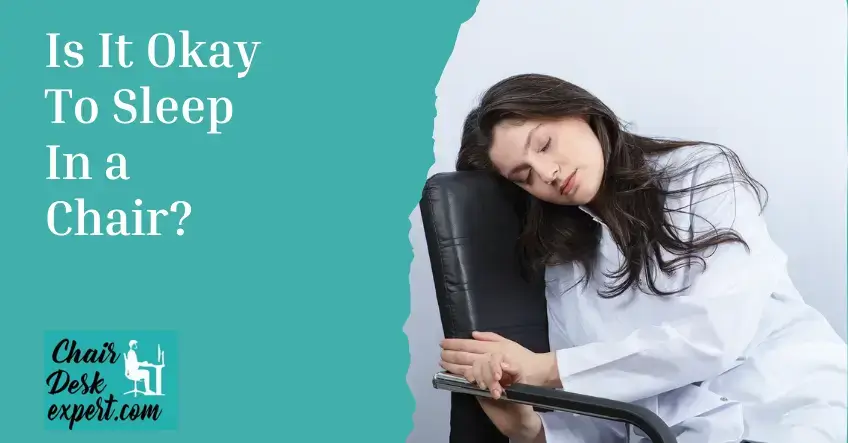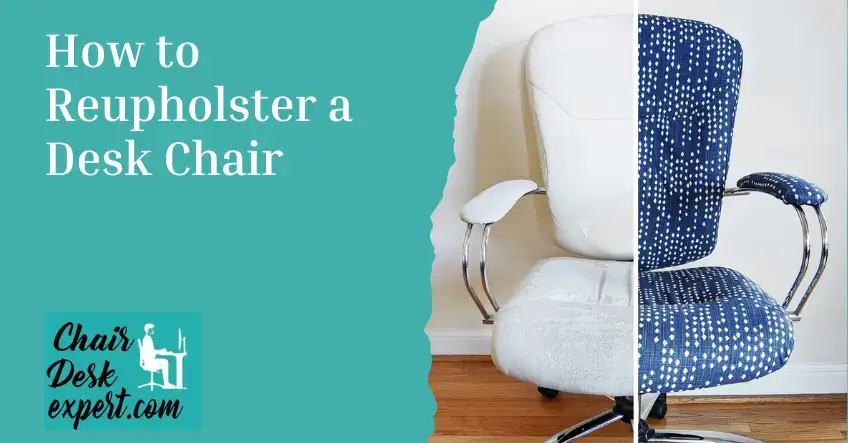While sleeping in a recliner may offer temporary relief for certain conditions like breathing difficulties or mobility issues, it’s important to consult with a healthcare professional before making it a regular habit.
Prolonged use can lead to various health problems, including back pain, neck strain, and circulatory issues. Always prioritize your well-being and discuss any concerns with a medical expert.
When you have a comfortable reclining chair that you spend most of your time on, it’s easy to sleep off when tired and, yes, even get a full night’s sleep!
This article explores the pros and cons of sleeping in your chair and some things to watch for when you have pre-existing conditions or are generally unwell. So, Explore with us: is it okay to sleep in a chair or recliner or not?
Is It Okay to Sleep in a Chair? Exploring the Pros and Cons!
Sometimes, sleeping in a chair or recliner becomes something you must do rather than want to do. There may be instances such as broken beds, recently moved houses, or waiting for delivery of another one, where staying erect while asleep is going to be the only option.
While recliners are often seen as comfortable and convenient, they are not designed for long-term sleep. While they can provide temporary relief for people with mobility issues or breathing problems, it’s crucial to consult with a healthcare professional before making them a regular sleeping spot.
Sleeping in a recliner can lead to various health problems, including back pain, neck strain, and circulatory issues. Although our bodies are naturally meant to lie flat when we fall asleep, sitting up may work best. Is it okay to sleep in a chair? Find out why.
Here is a comparison table for you to view it in a glance
| Feature | Chair | Recliner |
| Comfort | Generally Less | Often More |
| Posture | Unnatural | More Relaxed |
| Health Risks | Backpain, Neck Strain | Potential for Blood Clots |
| Support | Limited | Better for Back |
| Circulation | Can Impede | Can Improve |
| Breathing | Can be Difficult | Can be Easier |
| Portability | High | Low |
| Space | Small | Larger |
| Cost | Lower | Higher |
>> Read Also This Article: Replacing a Gas Lift in An Office Chair
Not Having a Bed:
Sitting on a chair or recliner is an option for relaxation when you lack a bed and do not want to rest on the floor. Recliners can offer a more comfortable sleeping position for those with limited mobility. The elevated position can also help with breathing problems by reducing congestion in the lungs. However, it’s important to remember that prolonged use can still lead to health issues.
Medical Conditions at Sleeping in a Chair:
Sleeping upright on a chair could be necessary due to temporary or chronic medical conditions. Colds or allergies that worsen when lying down induce nasal congestion and shortness of breath, making it difficult to lie down flat.
Other medical operations, such as cataract surgery and facial surgeries, may also eliminate the possibility of sleeping in the horizontal position or make it impossible.
It causes back pain at sleeping in a chair
Sleeping on recliners may have many advantages, particularly for people with acute backaches or recovering from back surgery.
Some people think it is easier to “go in” and “come out” of the chair than to go to bed, making it a more accessible alternative.
Furthermore, tilting your body backwards while sitting in a recliner means you can find the best angle for comfort and release pressure from your back.
However, placing a cushion at the lower part of the spine will give extra support, leading to more relief from pain.
For persons coming out of surgeries connected with their spinal columns, sleeping on such chairs becomes much better than lying on beds, especially when getting into bed is an uphill task.
In addition, compared with being seated straight in an armchair, this posture decreases stress placed on the posterior part of the lumbar, possibly enabling better alignment of spines and reducing strain within muscles around the lumbar area.
However, assuring adequate support for the lumbar while using these chairs is critical so as not to sit in them with a curved back, which may lead to further aches in the lower vertebral column region.
>> Read Also This Article: Benefits Of Swivel Chairs
Why Sleeping in Your Chair is So Difficult
Sleeping in a chair poses challenges that affect one’s rest and comfort. Although our bodies can naturally signal us when to sleep or wake up, certain factors contribute to difficulty achieving restful sleep while sitting.
Lack of Recliner Chair:
It is not easy to find a comfortable position where you can sleep without a recliner chair; it makes it difficult to get into the right frame of mind.
The absence of proper support and adjustment features may cause pain around the back, especially around the neck and back.
Alternate:
If you’re considering sleeping in a recliner, it’s essential to consult with a doctor to assess whether it’s suitable for your specific needs and health conditions. They can provide personalized advice and recommendations based on your individual situation.
Unnatural Body Position:
Sitting straight with your back at a 90-degree angle puts pressure on your lower back and neck. Consequently, this unnatural posture might lead to stiffness and pain when someone wakes up because his body has not been appropriately aligned during his natural resting position.
The Danger of Numbness:
Sitting in a chair for too long can cause numbness and discomfort in the legs due to reduced blood circulation and nerve pressure. This feeling of numbness can disrupt sleep even more, making one feel uncomfortable.
Rest insufficiency:
Despite trying to take short naps or breaks on their chairs, this may not result in enough sleep for optimal performance.
Such inadequate rest could be associated with tiredness as well as low productivity, particularly among office employees who use limited breaks to refresh their bodies.
>> Read Also This Article: What is an Ergonomic Chair?
How to sleep on a chair
You might find it hard to catch a nap while reclining on your office chair; however, some tips will let you relax sleepily throughout the night.
These are some ways through which you can position yourself in a tremendous sleeping posture while going to bed:
Position of the Neck:
Use a neck roll or pillow that supports your neck and keeps your head upright so your neck does not strain the muscles.
If the car’s headrests are adjustable, ensure they meet up with the top part of your skull at its backmost point.
Leg Positioning:
Slightly raise your feet above the ground level to enhance blood flow and relieve stress on the lower back area. For instance, use a footstool or ottoman so that your feet do not hang freely, thus hindering blood supply.
The Spine’s posture:
The chair’s backwards tilt eases pressure on your spine doing away with unnatural curvatures. Do not sit straight up for long hours since this would impact your back, making your muscles sore.
Supportive Accessories:
Consider purchasing additional helpful accessories such as lumbar cushions, seat cushions, or padded armrests to make yourself more comfortable and alleviate pressure points.
Take Breaks:
Whenever possible, stand up frequently during the night while you do muscle stretching exercises. This can help keep stiffness at bay and improve blood circulation.
>> Read Also This Article: What is a Drafting Chair?
Maintain Head Elevation:
If you decide to rest on your side, ensure the head is propped up enough to prevent neck straining. Find a cushion or rolled blanket that can act as a pillow.
Avoid Non-Ergonomic Chairs:
Standard dining rooms or office seats without ergonomics should never be used due to the likelihood of developing discomfort while asleep.
Opt for a Reclining Chair:
Choose a reclining chair equipped with a footrest and headrest for optimal comfort and support while sleeping. This will enable you to adjust the chair’s position to suit your needs, thus enabling better relaxation.
Use Supportive Pillows:
If the bed does not recline, try using lumbar support pillows under your lower back, neck pillows beneath your neck, and headrests. These accessories provide extra support and help maintain proper alignment while sleeping.
Set the alarm:
Put an alarm on the chair before falling asleep so that you do not oversleep but wake up early. This enables one to resume his/her normal activities immediately after resting.
>> Read Also This Article: Avoid These 7 Non-Ergonomic Chair (Mistakes)
Pros:
Reduces Acid Reflux:
By angling its backrest above the stomach, raising the head helps to prevent stomach acid from leaking back into the throat, thus preventing heartburn or sore throat resulting from acid reflux disease.
Aids Digestion:
An inclined back angle may serve as an efficient way of reducing acid regurgitation by improving digestion after meals.
Breathing in the right way:
Sleeping short of entirely lying down helps to reduce pressure on the chest and lungs, which is suitable for people with breathing problems such as asthma. Additionally, this could help minimize snores.
Reducing Back Pains:
Conversely, sleeping inclined can relieve pain for patients with chronic back ailments such as sciatica. The position reduces the pressure the spinal cord applies on nerve endings, thus improving alignment between spinal bones and relieving sciatic pain.
Read more : >>>> Best Desk Chair For Back Pain [Top 14 Picks Reviewed!]
Improved Circulation:
Leg elevation above hip level helps to return the blood to the heart, thus enhancing blood circulation and reducing inflammation.
Collapses Swellings:
Better circulation directly leads to decreased swelling and edema, which affects those with fluid retention problems.
Compactness Solution:
Instead of a bed or a recliner chair alone, one can buy a rise recliner chair that doubles as a bed hence saving space, especially in areas where there is not enough room for both a bed and chair.
>> Read Also This Article: What is an Executive Chair
Cons:
Muscle Stiffness:
Compared with laying flat on a bed, when you sleep in a chair, muscles never get an opportunity to relax fully, and this may cause pain as well as stiffness.
Deteriorates Underlying Illnesses:
Unlike having rest while asleep in your home’s bed, sleeping on chairs does not provide complete rest needed for some physiological functions that can help treat certain chronic diseases such as angina pectoris, neuralgia etc.,
Making it difficult for doctors treating their patients suffering from diseases like these since they cannot be managed effectively if they are put on chairs while asleep but instead should be placed at their beds unless directed differently by their physician.
Cramped conditions:
Sleeping upright constricts movement, inhibiting easy change of postures, whereas limited spaces promote falling out of seats during movements at night time, even during slumber
Twists around: Sitting too long on a chair will tighten muscles around hip and knee joints, making them contractures.
Increased chances of DVT:
Sitting for long can increase stress and pressure on the lower legs, which in turn raises the risk of deep vein thrombosis (DVT).
A person can opt to sleep in a chair if he or she has some disability issues or suffers from certain diseases. However, this type of sleeping is not without its dangers: deep vein thrombosis and aggravated connected ailments.
So, any person who wants to sleep sitting on a chair should see a doctor who will say whether this is allowed depending on one’s condition.
Can you sleep in a recliner?
Yes, a recliner is quite a beauty, and some people can even fall asleep in it better than what they would experience in a bed, especially under some conditions. Practicing sleeping in a recliner is safe for people since most people practice this with a purpose for conditions like sleep apnea, GERD or back pain. Still, to help you fall asleep in a recline position and remain asleep as well, consider the following pointers:
How to Sleep in a Recliner without Strain:
Cover Leather Surfaces: If the recliner is leather, cover it with a sheet or quilt to help with night sweats.
Keep Warm: Swaddle doubly, if necessary, with enough warm blankets to cover you throughout the cold night because recliners may sometimes feel cooler than beds.
Use Pillows:
A pillow for neck support should be put behind your neck.
A pillow should be placed at the lower spine to slightly curve the lower back muscles.
Leg Support: Rest your legs on the footrest of the recliner or use a pillow beneath them. Compression socks can also be worn if swelling is an issue to help with blood flow.
Comfort and Safety: When leaning backward in a reclining chair, pay attention to the angle of the seat about your chest. This angle can help cut off breathing or blood flow. Be careful and make sure that your entire body is well supported.
pros and cons of sleeping in a recliner
Sleeping in a recliner has its pros and cons let’s discuss
dangers of sleeping in a recliner chair and see if it has benefits.
Adverse Effects of Sleeping in a Recliner
The effects of dozing off in a recliner will be dealt with, and why it is advisable to go to bed every night will be outlined. Here are a few side effects you may have to contemplate, together with the suggested course of action.
Breathing Problems
While sleeping in an upright position can cure breathing problems for some, it can also cause breathing problems. An over-arched upper back will prevent a total intake of air over time. This effect can be harmful to people with lung disease; hence, sleeping in a recliner is not a good idea for them.
Joint Stiffness
That ache we all feel in our limbs after a long period of pressure is known too well. In a recliner, where there is chronic flexion of the knees and hips throughout the night, such sleeping positions will promote stiffness of the hip/calves/hamstrings over time. This will bring about discomfort in the short run and a chronic risk to posture.
Possible Loss of Balance
Sleeping occasionally in the recliner will be harmless for any length of time, but sleeping in the recliner consistently poses the risk of developing knee and hip contractures, more so muscle tightness around the joints. This may severely hinder your ability to stand up straight, as well as balance and mobility in the long run.
Shallow Sleep
Recliners have little room, making it difficult for the body to go to deep levels of sleep, such as REM. This leads to poor sleep, where one has sore muscles and is not rested. A lack of a proper sleep-wake cycle leaves one lacking energy and wellness.
Deep vein thrombosis
Continually sleeping in a reclining chair in a semi-fetal position may also disturb blood circulation and enhance the risk of developing deep vein thrombosis (DVT), a severe and potentially lethal threat.
A clot forms in a deep vein, typically in the legs. Sleeping and sitting also increase the risk of DVT, and any position involving total knee flexion, especially behind the knees, risks stasis developing.
Benefits of Sleeping in a Recliner without Being a Frequent Sleeper on It
Even in the negatives, sleeping in a recliner has some positives, such that one should not get addicted to sleeping in the recliner.
Circulation:
Lifting your feet at the end of a long day’s work, especially after a prolonged sitting or standing, may be effective. Elevating the lower limbs higher than the heart level can decrease swelling and help regain strength after tiring days; thus, intermittent chair use is suitable for comfort.
Treatment of Backache
Spinal decompression while reclining may help people with lower back problems and help the abdominal muscles relax. Raising your legs increases blood circulation to the lower back as well. But rather than sleeping in the recliner, you should use it for relaxation so that you don’t have problems after some time.
How to make sleeping in a recliner more comfortable
If you plan to sleep in a recliner for long hours, taking these steps will make such an uncomfortable sleeping position easy and less harmful to your body:
Head and Neck Support.
Use a thin pillow: It is recommended that you put a thin pillow or a rolled towel under the nape of your neck, which will help you maintain your spine’s natural cervical lordosis. Avoid high pillows, especially those that seem to tilt your head too much to avoid straining the neck.
Consider a neck pillow: A travel neck pillow would prevent your head from tilting aside and help it stay in a neutral position.
Arms: Shoulders, Elbows and Hands
Elevate your arms with pillows: For comfort, place a pillow under the arms of the fig, which may cause discomfort to the elbows and shoulders. This relieves pressure, allowing the arms to relax through the night and cutting strain on tensioning the arms in unusual positions.
Lumbar Support
Add lumbar support: You can place a thin pillow or a rolled towel on the small side of your back to support the spine curve. This helps in even distribution of weight on all three curves of the vertebral column, hence attributing to pelvic issues.
Adjust the size: You can also adjust the size of the lumbar support, which is also adjustable. This will achieve comfort by preventing the lumber support from being too deep; an arch is usually present when one is lying on the bed flat.
READ MORE:>>> 5 Best Desk Chairs for Ultimate Comfort and Style (2025 Guide)
Hips, Knees, and Legs
Fill the gap under your legs: If there is a gap between the recliner’s base and the footrest, it is advisable to put a pillow or blanket under your thighs to ensure that the knees are not rigid and fluids do not accumulate.
Elevate your feet: To avoid inflammation, stacking pillows under the foot and legs will help keep the legs elevated. This also reduces heel stress and lowers the chances of having pressure ulcers.
Float Your Heels
Use a pillow to “float” your heels: Place the foot of the heel at the tip of a pillow as you lay in a recliner chair so that the effect of pushing your heel backwards is reduced through pressure point hardware.
Adding these simple positioning aids that require some changes for support will make sleeping on a reclining couch less uncomfortable, more so when one is recovering from surgery, has some injury, or wishes to recliner for a quick snooze.
READ MORE:>>> Find Your Perfect Fit: 5 Best Office Chairs Under $300
Wrapping Things Up
So, Is it okay to sleep in a chair? While sleeping in a chair can offer convenience for individuals with mobility issues or certain medical conditions, potential risks such as deep-vein thrombosis and exacerbation of underlying health issues must be considered.
Consulting with a medical professional is advisable to determine if sleeping in a chair suits individual circumstances.
FAQs on is it okay to sleep in a chair?
1-Can I sleep sitting in a chair?
A: Sleeping while seated in an inclined position would not be harmful. However, it could lead to an increased risk of DVT, i.e., blood clotting in your limb due to bending your arms or legs and keeping still for many hours at a time. Such instances usually occur when people are almost motionless for long hours on planes.
2-Does sleeping in a chair have any advantages?
A: Sleeping upright helps people with limited mobility breathe better and improves circulation. Yet it may also worsen other underlying medical conditions; hence, it must not be taken lightly but discussed with medical professionals prior to implementation.
3-Why can I only sleep in a chair?
A: For others, there are some health issues where lying flat is less comfortable than being propped up. Some examples include morbid obesity and chronic obstructive pulmonary disease (COPD). Other individuals might simply feel they rest better when tucked inside their recliners.
4-Which sleeping position is best for you?
The finest sleeping position is on your side, with a pillow or sheet between your legs. Neck or back pain can be decreased in side sleepers who do this. Select a pillow with the same loft as the distance from your shoulder to your neck.
5-What’s the best way to sleep while sitting?
A: Another option is to lean back slightly so you’re not fully upright. After that, use a neck cushion or rolled-up towel to support your head. By the way, keep those feet flat on the floor. It is almost like sleeping in an airline seat except for the turbulence and snoring man beside you.
6-Is sleeping in a chair bad for circulation?
If you’re sleeping in a recliner and experiencing poor circulation, your heart might be working harder than it should,” says Nuzzo. “This can lead to an elevated risk of blood clots.
7- Why shouldn’t you sleep with a chair in your room?
According to popular belief, cold rooms with empty chairs can create an inviting atmosphere for spirits to watch over you while you sleep.









